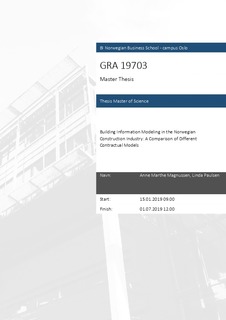Building Information Modeling in the Norwegian Construction Industry: A Comparison of Different Contractual Models
Master thesis
Permanent lenke
http://hdl.handle.net/11250/2623111Utgivelsesdato
2019Metadata
Vis full innførselSamlinger
- Master of Science [1621]
Sammendrag
The adoption of building information modeling (BIM) among construction firms,
can contribute to resolving many of the issues inherent in today's construction
industry. However, despite a proliferation in BIM adoption across the Norwegian
construction industry, these issues remain. We suggest that this can partly be
explained by the delivery models that govern construction projects. This master
thesis builds on transaction cost economics, and aims to extend previous literature
on how contractual models can act as boundary conditions for effective use of BIM.
Seven propositions were developed on the basis of case study evidence from eight
construction projects in Norway. Findings suggest a relationship between different
contractual models and effective use of BIM. The strength of this relationship was
also found to depend on a set of conditional factors. Novel contributions are: first,
to identify characteristics of BIM exchange; second, to offer some insights on the
contextual appropriateness of different delivery models in governing BIM
exchange; and third, to explain how different contractual models can play a
complementary role in governing the exchange of information in BIM. The study
offers practical implications for project owners seeking effective use of BIM. Most
notably, project owners should be aware of the opportunities and challenges of the
different contractual models with regards to BIM. They should also pay attention
to the contextual factors that may influence the relative effectiveness of the different
contractual models.
Beskrivelse
Masteroppgave(MSc) in Master of Science in Business, Strategy - Handelshøyskolen BI, 2019
